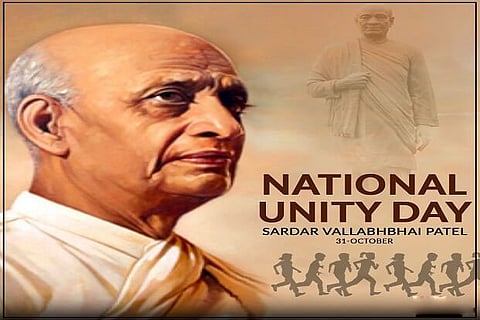
- Home
- Live Blog
- Breaking News
- Top Headlines
- Cities
- NE News
- Sentinel Media
- Sports
- Education
- Jobs

After Independence in 1947, Sardar Patel took the biggest challenge as India’s first Deputy
Prime Minister and Home Minister to unite 565 princely states into the Union of India, which earned him the title ‘Iron Man of India’ – Sonit Kumar Goswami (journosonit@gmail.com)
Bharat has been celebrating the birthday of Sardar Vallabhbhai Patel as National Unity Day, or Rastriya Ekta Divas, since 2014 to reaffirm and strengthen national unity and integrity. This year the nation marks the Rashtriya Ekta Divas and the 150th birth anniversary of Sardar Patel. The message is both timeless and urgent. A united India is not just our heritage but our most enduring strength.
Since Independence, India has faced tough challenges from outside forces to weaken its core with diversity and a secessionist mindset. However, the nation has been following the vision of the first Deputy Prime Minister of India, Sardar Vallabhbhai Patel, in integrating and building the nation as one nation, a strong nation. It was the vision of Sardar Patel, who dived into the diversity of the newly found state in 1947 to unite all princely states without bloodshed to make present-day Bharat a rising force in the world.
Sardar Vallabhbhai Patel’s vision of Unity in Diversity is reflected in the Unity Day or the Run for Unity programme, as across the nation we see the participation of people from different cultural and ethnic backgrounds to strengthen the concept of Unity in Diversity of India. The vision of a unified strong nation of Sardar Patel has a clear message in strong nation building in this 21st century.
The journey of Sardar Vallabhbhai Patel’s transformation from a small-town lawyer to India’s “Iron Man” shows his remarkable character. Sardar Patel was born in Nadiad, Gujarat, on October 31, 1875. He was born into a modest agricultural family and continued his early education in Nadiad, Petlad and Borrsad. He established himself as a country lawyer and started to save money. His determination led him to England in 1910 to study law at Middle Temple Inn. He completed his law course in two years instead of three and won a prize in Roman law.
Vallabhbhai Patel returned to India in 1913 and built a successful legal practice in Ahmedabad. His life changed dramatically after meeting Mahatma Gandhi in Godhra in 1917, which transformed his path to embrace Khadi cloth and abandon the European cloth. The Khera Satyagraha of 1918 marked his deeper involvement in politics. Working as Gandhi’s deputy, he organized farmers against unfair taxation. In the 1928 Bardoli Satyagraha, Vallabhbhai Patel showed his leadership qualities, which earned him the “Sardar” (a leader) title. This achievement secured his position in India’s freedom struggle and laid the foundation for his crucial role in national integration.
After Independence in 1947, Sardar Patel took the biggest challenge as India’s first Deputy Prime Minister and Home Minister to unite 565 princely states into the Union of India, which earned him the title “Iron Man of India”. Sardar Patel’s diplomatic approach worked well, as he promised the princely states benefits such as privy purses and protection under India’s new government. At a time when diplomacy didn’t work, as in the case of Junagadh and Hyderabad, he didn’t think twice about using military force. The nawab of Junagadh wanted to join Pakistan, but Patel’s quick action brought it into India; the same also happened with Hyderabad’s Nizams, who gave it after Operation Polo in 1948.
Besides integrating Indian states, Sardar Patel also helped the partition refugees. Sardar Patel is also credited with creating the All India Services System, which he labelled as the “Steel Frame” of the nation. This made him known as the “Patron Saint of India’s Civil Servants”.
Sardar Patel managed to achieve the integration of Indian Princely States without bloodshed; he told the Constituent Assembly that the new Constitution must show “not an alliance between democracies and dynasties, but a real union of the Indian people”. Patel’s dream of a unified administration and territorial integrity is honoured rightfully on his birth anniversary on October 31st, now known as National Unity Day.
Bharat has been celebrating National Unity Day (Rashtriya Ekta Diwas) on 31st October since 2014. The Run for Unity serves as the lifeblood of this celebration as people from all walks of life come together to run distances ranging from 3 to 10 kilometres, pledging themselves to preserve national unity, integrity and security.
The government has also been conferring the Sardar Patel National Unity Award from 2019, recognising outstanding contributions towards promoting national unity. The two-year birth centenary celebration from 2024 to 2026 includes the “Sardar@150 Unity March” beginning on November 26 and ending on December 6, 2025, which will cover 152 km from Patel’s birthplace in Karamsad to the Statue of Unity in Kevadia. Youth will participate through NSS, NCC and My Bharat platforms, showing how Patel’s vision of “Ek Bharat, Shrestha Bharat” is inspiring new generations.
The 150th birth anniversary celebration will spread Patel’s lasting message to a new generation, as young Indians will connect with his legacy through the planned “Sardar@150 Unity March”. The massive Statue of Unity in Kevadia is more than a tourist spot, as it reminds us of Patel’s huge impact on our nation’s path. His dream of “Ek Bharat, Shrestha Bharat” stays just as important now as we tackle today’s challenges to our unity. Taking strength from Iron Man’s legacy and through his birth anniversary, we must help ourselves to look back at our history and guide ourselves toward our future as One Nation.